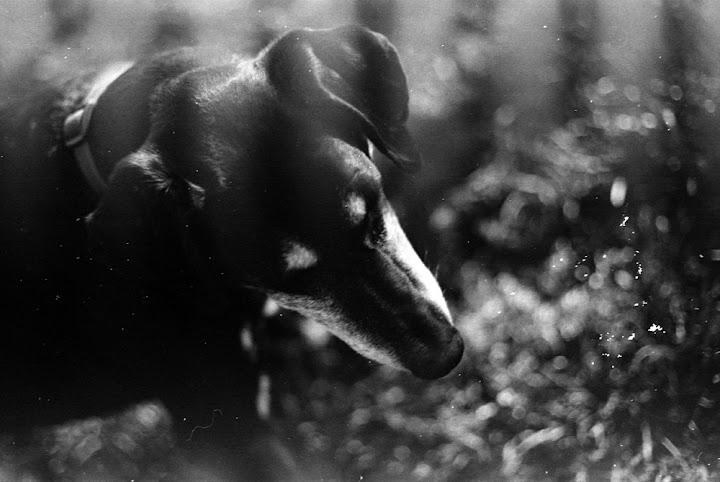David

Joined: 13 Apr 2011
Posts: 1869
Location: Denver, Colorado
Expire: 2013-01-25
|
 Posted: Mon Aug 27, 2012 6:32 am Post subject: Kodak 2383 Posted: Mon Aug 27, 2012 6:32 am Post subject: Kodak 2383 |
 |
|
David wrote:
I'm not sure if the film I got that was labeled Kodak 2383 is actually 2383. 2383 is a Kodak Vision with an antihalation layer. The film I have is the only film base I've ever seen that's translucent BEFORE processing. Also, I have to expose this stuff like it's ISO 1 or 2. Seriously, I finally figured out how to get suitable photos with it, but only because I metered it at ISO 6 (the lowest my meter would go to) and then (accidentally) shot all the images two shutter speeds slower than the meter indicated.
Also, this film has NO edge markings, and I would have thought all of Kodak's films would have edge markings. I'm of the mind right now that this may be microfilm base that was recanned into a 2383 tin.
You may recall my first (successful) foray into this film which yielded results like this:

This was actually from the third roll of 2383, but the first that yielded usable images.
Some further experimentation and the theory floated on this board that the 'teeth' along the top are light leaks proved to be correct. By orienting the film during respooling from the 2,000-foot roll into 100-foot rolls, as long as the light-damaged side is oriented to be upward on the final print, the light from the sky will eradicate the existing light damage.

There's a VERY, VERY faint hint at light damage in the vignetting in the upper left. This image shows, a bit better, that the light damage is not erased, simply covered:

So, basically, here is how I exposed these:
sunny afternoon (about 5:00 PM, clear sky) in direct sun: f1.8, 1/15th of a second exposure; f2, 1/8th of a second exposure; and f2.8, 1/4-second exposure. That yielded usable results.
Here are some other samples (also, I did NOT have a tripod, so I had to hand-hold these. A couple have some camera shake from it.) All were shot with my Pentax H3V (I'll explain later why that accidentally led to these images being usable):
1 -- Focal 28mm, f2.8, 1/30th

2 -- Focal 28mm, f2.8, 1/8th

3 -- Focal 28mm, f2.8, 1/15th

4 -- Takumar 55mm, f1.8, 1/15th

5 -- Focal 28mm, f2.8, 1/15th or 1/8th (I forget which)

6 -- Focal 28mm, f2.8, 1/8th

My few shots at 1/4 were too shaky. So, here's what's embarrassing. I thought the entire time I was shooting at 1/60th and 1/30th, with a couple taken at 1/125th. I kept thinking, 'man, these shutter speeds seem really long today, but this camera just got a CLA five rolls ago. So my perception must be off.' Well, my perception wasn't off. Every time I thought I had it set for 1/30th, it was really set at 1/8th. All the 1/60th shots were 1/15th. Why? I thought the red indicator dot was also the shutter speed indicator. It didn't occur to me, until the end of my second roll, that the shutter speed indicator might be on the dial. Therefore, all my shots were two shutter dial slicks overexposed. So, it's a good thing I didn't treat this film like ISO 6 -- everything would have been horribly underexposed.
That brings me back to why I think this may be a microfilm base. There's no way I'm believing this is a color print film with an antihalation dye layer. The film also does not appear to have multiple emulsion layers. Also, when being developed, the developer comes out either clear or very light green, not mucky or yellow like it does when normally developing color film in D-76. Oh, and this stuff does not have 2383's blue-purple emulsion color, like 250 D, so I think 2383 is ruled out.
Sadly, I'll never likely know what this film is. No markings on the film gives me very little to go on. And Kodak's technical data confirms that the film number and stip data are printed on the film's edges.
But, I'm not looking a gift horse in the mouth. 2,000 feet of the stuff was $30, making it the single best deal I've ever gotten in not-free film. Likely, I will never beat that deal. Thank you, eBay, for making me this happy.
Anyway, if I knew what this was for sure, I'd get it any time I could. I like the tonal range a great deal. The look is slightly vintage, but not overpoweringly so. Also, the ultra-low nature of this film means that it might yield highly detailed results in a different developer than my aging D-76. In fact, just this week, I got some concentrated Bluefire developer designed for the Bluefire Police film. I plan to try it with that film, Adox 25, and this film. I'll also give this a shot with Microdol or one of the other non-D-76 developers in my closet.
_________________
http://www.youtube.com/user/hancockDavidM |
|
